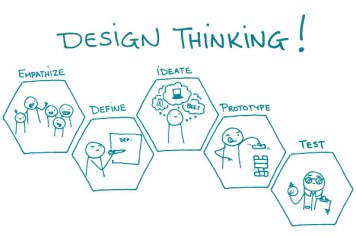In the past, I believed that creativity was a trait people are born with. But, now, after completing the first module of this course, I totally believe that creativity can be learned and practiced. At this point in time, I consider myself a lot more creative than I used to be. I have gained the ability of identifying, practicing and evaluating Design-thinking; which is a major process in creative thinking and creative problem solving. From where I stand, the most helpful source on D-Thinking was the IDEO shopping cart in the video below.
One of the greatest things that I have learned in this Module is Divergent Thinking; a process or a method used to generate creative ideas by exploring all the possible solutions, while avoiding judgment. At the beginning of most of the classes, Doctor Sherif prepared 2-4 minute activities that were fast paced and were mainly based on throwing out ideas, in my point of view, these activities were a way to exercise and warm up our brains to become more creative, we were always asked to target quantity not quality, to enhance our divergent thinking skills. Moreover, these activities were extremely engaging and from one class to the next I could see my progress from 5 ideas on my list to 15.
As I proceeded in the course, I learned how to reframe problems by looking at them from a new outlook or viewpoint, and understanding that applying these problems can present new opportunities and ideas that might bring about an improved solution.
For a long period of time, I faced a problem called Functional Fixedness, which is the cognitive bias that limited me to using or perceiving an object or an idea only in the way it is traditionally used or perceived. But when I focused on this problem and saw how deteriorating it was, I eventually reduced it; so that I can become a creative person. In order to become a creative person, one must be curious enough to enquire the unknown and ultimately discover nonexistent solutions. Usually, I perceive myself as a curious person.
We spent some time during this module talking about Empathy; a user-centered design approach that pays attention to the user’s feelings toward a product.To gain a more effective understanding of empathy, we were asked to produce a podcast about our experiences in AUC.
In our final mini-challenge, we were assigned to groups and we were asked to find a solution for a stage in the journey map of a food of our choice – we chose transporting potatoes. At first, my group and I focused on grasping the main problem which was a disease called Soft-Rot disease which is a form of bacteria that evolves in potato tubers during the harvesting period, as it is a contagious disease, if it is not properly handled or controlled it will spread. We conducted plenty of local research, went into the field to observe, created an interview for empathy, researched existing solutions, and finally put everything together. In a class activity, we were asked to come up with as many solutions individually, later on we were asked to use SCAMPER to substitute our solutions with better alternatives, combine similar or related solutions, adapt what are much the same, modify what can be added or subtracted, put other uses of solutions together, eliminate unnecessary aspects, and rearrange our solutions to find the most fit arrangement. After going through all the phases of D-Thinking we reached the final solution – PTruck. The PTruck is a truck that contains a large tube, through which the potatoes are loaded and sprinkled with an antibacterial spray that kills the disease in the contaminated potatoes and prevents the soft-rot disease from infecting the healthy potatoes.

In Module 1, I believe that I have seized the ability to; produce creative solutions to the challenges I was given in the class and build prototypes that demonstrate the solution I have in mind. Finally, the most important thing that I have learned in this module is Critical Thinking; the objective analysis, understanding and evaluation of an issue or a problem in order to form a correct judgement.

April 12, 2017 at 12:01 pm
Reblogged this on 'Where's the box? Creative thinking and problem solving" and commented:
great example of using images and referring to previous work in the module!
LikeLike